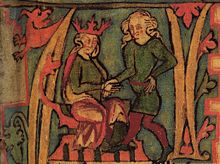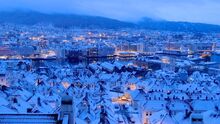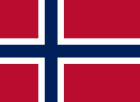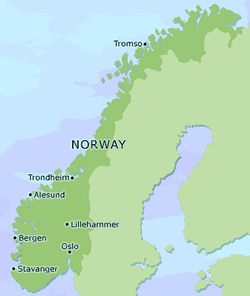| Kingdom of Norway Kongeriket Norge (Norwegian Bokmål) Timeline: Nuclear Apocalypse: 2014
Kongeriket Noreg (Norwegian Nynorsk) Norgga gonagasriika (Northern Sami) OTL equivalent: Norway | ||||||
|---|---|---|---|---|---|---|
|
||||||
| Anthem: Ja, vi elsker dette landet (de facto) Royal anthem: Kongesangen |
||||||
| Capital | Trondheim | |||||
| Largest city | Bergen | |||||
| Other cities | Drammen, Kristiansand, Ålesund, Tønsberg | |||||
| Official languages | Norwegian Norwegian: norsk (Bokmål/Nynorsk) Sami (Northern Sami/Lule Sami/Southern Sami) |
|||||
| Regional languages | Kven, Tavringer, Romani | |||||
| Writing system | Latin (Dano-Norwegian alphabet) | |||||
| Ethnic groups (2017?) | 82.2% Norwegian 9.5%Sami 5.8% Traveller 1.2% Forest Finn 1.1% Romani 0.1% Kven |
|||||
| Religion | Secular | |||||
| Demonym | Norwegian Norwegian: Nordmann |
|||||
| Government | Unitary parliamentary constitutional monarchy | |||||
| - | Monarch | Ingrid | ||||
| - | Princess Regent | Mette-Marit Tjessem Høiby | ||||
| - | Prime Minister | Erna Solberg | ||||
| Legislature | Storting | |||||
| Establishment | ||||||
| - | State established prior unification | 872 | ||||
| - | Norwegian Empire (Greatest indep. extent) | 1263 | ||||
| - | Kalmar Union | 1397 | ||||
| - | Denmark-Norway | 1524 | ||||
| - | Brief Period of Independence | 25 February 1814 | ||||
| - | Sweden-Norway | 4 November 1814 | ||||
| - | Dissolution of Sweden-Norway | 7 June 1905 | ||||
| - | Nuclear Holocaust | 9 September 2014 | ||||
| Area | ||||||
| - | Total | 385,178 km2 148,718 sq mi |
||||
| - | Water (%) | 5.2 | ||||
| Population | ||||||
| - | 2017 estimate | 3,063,456 | ||||
| - | Density | 15.8/km2 40.9/sq mi |
||||
| Currency | Norwegian krone | |||||
| Time zone | CET (UTC+1) | |||||
| Date formats | dd.mm.yyyy | |||||
| Drives on the | right | |||||
| Calling code | +47 | |||||
Norway (NAWR-way; Norwegian: Norge (Bokmål) or Noreg (Nynorsk)), officially the Kingdom of Norway, is a sovereign state whose territory comprises the western portion of the Scandinavian Peninsula plus the remote island of Jan Mayen and the archipelago of Svalbard. The Antarctic Peter I Island and the sub-Antarctic Bouvet Island are dependent territories and thus not considered part of the Kingdom. Norway also lays claim to a section of Antarctica known as Queen Maud Land. Until 1814, the kingdom included the Faroe Islands, Greenland, and Iceland. It also once ruled over Bohuslän until 1658, Jämtland and Härjedalen until 1645, Shetland and Orkney until 1468, and the Hebrides and Isle of Man until 1266.
Norway has a total area of 385,252 square kilometres (148,747 sq mi) and a population of 3,063,456 (according to the census taken on January 2017). The country shares a long eastern border with Sweden (1,619 km or 1,006 mi long). Norway is bordered by Finland and what was once Russia to the north-east, and the Skagerrak strait to the south, with Denmark on the other side. Norway has an extensive coastline, facing the North Atlantic Ocean and the Barents Sea.
Following the nuclear war of 2014, Norway lost many of her major cities, including the captial city of Oslo as well as much of her population. The Norwegian's struggled to rebuild their country thanks to nuclear fallout and nuclear winter. The nation survived mainly due to a morale boast created by the popularity of King Harald V and his successors King Haakon VIII and Queen Ingrid. The capital of Norway was relocated to Trondheim and the country is becoming increasingly stable, although many citizens remain isolated ever since technology such as computers and smart-phones became obsolete. Norway is one of the few European nations to survive to the Nuclear War.
History[]
Before Doomsday[]

Harald Fairhair, the first King of Norway
About 10,000 BC, following the retreat of the great inland ice sheets, the earliest inhabitants migrated north into the territory which is now Norway. They traveled steadily northwards along the coastal areas, warmed by the Gulf Stream, where life was more bearable. In order to survive they fished and hunted reindeer (and other prey). Between 5,000 BC and 4,000 BC the earliest agricultural settlements appeared around the Oslofjord. Gradually, between 1500 BC and 500 BC, these agricultural settlements spread into the southern areas of Norway - whilst the inhabitants of the northern regions continued to hunt and fish.
The Neolithic period started 4000 BC. The Migration Period caused the first chieftains to take control and the first defenses to be made. From the last decades of the 8th century Norwegians started expanding across the seas to the British Isles and later Iceland and Greenland. The Viking Age also saw the unification of the country. Christianization took place during the 11th century and Nidaros became an archdiocese. The population expanded quickly until 1349 (Oslo: 3,000; Bergen: 7,000; Trondheim: 4,000) when it was halved by the Black Death and successive plagues. Bergen became the main trading port, controlled by the Hanseatic League. Norway entered the Kalmar Union with Denmark and Sweden in 1397.
After Sweden left the Kalmer Union in 1523, Norway became the junior partner in Denmark–Norway. The Protestant Reformation was introduced to the country in 1537 and absolute monarchy imposed in 1661. In 1814, Norway was ceded to the king of Sweden by the Treaty of Kiel. Norway declared its independence and adopted a constitution. However, no foreign powers recognized the Norwegian independence but supported the Swedish demand for Norway to comply with the treaty of Kiel. After a short-lived war with Sweden, the countries concluded the Convention of Moss, in which Norway accepted a personal union with Sweden, keeping its Constitution, Storting and separate institutions, except for the foreign service. The union was formally established after the Storting adopted the necessary amendments to the Constitution and officially elected Swedish King Charles XIII as King of Norway (reigning as King Charles II) on 4 November 1814.
Industrialization started in the 1840s and from the 1860s large-scale emigration to North America took place. In 1884, King Oscar II appointed Johan Sverdrup as prime minister, thus establishing parliamentarism. The union with Sweden was finally dissolved in 1905. From the 1880s to the 1920s, Norwegians such as Roald Amundsen and Fridtjof Nansen carried out a series of important polar expeditions.
Shipping and hydroelectricity were important sources of income for the country. The following decades saw a fluctuating economy and the rise of the labor movement. Germany occupied Norway between 1940 and 1945 during the Second World War, after which Norway joined NATO and underwent a period of reconstruction under public planning. Oil was discovered in 1969 and by 1995 Norway was the world's second-largest exporter. This resulted in a large increase of wealth. From the 1980s Norway started deregulation in many sectors and experienced a banking crisis.
9 September 2014 and the Aftermath[]
A week before Doomsday, American President Barack Obama ordered NATO, including Norway, member-states to send ships to the Black Sea in order to challenge Russia. The President of the Russian Federation, Vladimir Putin, sent an ultimatum to Washington, demanding that NATO ships leave the Black Sea by September 7. NATO refused to comply and the ships remained. On September 7, Russian ships fired upon the NATO armada. In response, President Obama met with his cabinet and decided to fire America's stockpile. The nuclear exchange between NATO and Russia along with her allies lasted no longer than two hours. Millions perish in the blast zones and major cities, such as New York and London, are wiped off the map.
When news of the American attack reached Oslo, the royal family and the government evacuated the capital to a safe distance (which remains top secret). At this location, the King held an emergency meeting with his government. The city of Trondheim was set up as the new capital of Norway, the government worked to re-establish stability in the country. Oslo was destroyed that afternoon, instantly killing an estimated 300,000 people. Communications and electricity was knock out, isolating many civilians and rendering technology such as smart phones obsolete. The weather began to change dramatically, beginning the period of Nuclear Winter. Thanks to low population density, the majority of the Norwegian people live in rural areas, the Norwegians were mostly unaffected from radiation poisoning, faring better than the Former Federal Republic of Germany and the French Republic.

Russian soldiers surrendering to the Norwegian armed forces in December 2014.
The Government of Norway feared an invasion from what remained of the Russian armed forces in Finnmark. What remained of the Norwegian armed forces were sent to Finnmark in order to put up an defensive barrier and to their surprise, the Russian forces that marched into Finnmark do not want to fight anymore. Many of them lost family and friends during the Nuclear exchange and they peacefully surrendered to the Norwegians in December 2014.
In the winter of 2014-2015, following crop failures as a result of the drop in global temperature, many Norwegians began to starve. The Norwegian government ordered the Svalbard Global Seed Vault to plant their collection of seeds in order to assist the starving populous of the country.
In early 2015, a series of deadly race riots occurred throughout Norway. Some ethnic nationalist movements believed that native Norwegians should be the priority instead of immigrants and those of recent immigrant background. The main target of these movements were those of North African and Middle Eastern ancestry. In February of 2015, several Mosques were burnt to the ground. Three Arabian men, accused of gang raping a fourteen year old girl, were violently hung and hacked to pieces. The dramatic rise of racial tension saw a mass-exodus of ethnic minorities with non-Western ancestry from Norway.
By the Spring of 2015, contact was re-established with Denmark when a Norwegian coast guard ship encountered a Danish warship off the coast of Bergen. The crew of the Danish ship were met with celebration by the people of Bergen, and King Frederick X of Denmark would travel to Norway to re-establish ties between the two Nordic nations.
Despite of the xenophobic race riots that had plagued the country months before, Russian refugees began settling in Northern Norway and Sami refugees from Sweden illegally crossed the Swedish-Norwegian border in increasing numbers. However, the Russian and Sami refugees are far more tolerated in the new Norway than those of African and Arabic ancestry. Left wing groups in Norway refer to this as a "tragic and disgusting rise in racism" within the country.
In July 2015, Norwegian soldiers encountered Russian troops from what was once Northwestern Russia. These Russians claim to be from the recently establish Russian survivor state of Karelia. King Haakon VIII and Foreign Minister Børge Brende personally visited Karelia and Norway was among the first to recognize the Republic of Karelia. Norway also recognized the Sápmi Republic and the Kingdom of New Amsterdam in the Autumn of 2015.
During the winter of 2015/16, survivors of the Oslo blast were being resettled in new homes Bergen and Trondheim. The city of Trondheim was officially declared as the country's new capital city, after acting as the de facto capital since September 2014. Electricity was brought back, although in a limited manner, the internet was forever knocked out and Norwegians once again rely on Newspapers, Radio and Television News in order to receive information. Many starving Norwegians were now able to have food thanks to the Seed Vault. The time and progress the nation has undergone in order to recover amazed many of the people, that Erna Solberg was reelected as Norway's Prime Minister in a surprise General Election.
Although the majority of Norwegians desired peace, but the country was draw into war once again. It is unknown what started the new conflict, but official reports state that Scottish warships open fired on a Norwegian Coast Guard vessel, forcing the recovering but still exhausted nation to declare war on the young Scottish Republic.
The Royal Norwegian Navy reached the islands of Shetland and Orkney and opened fired on the fleet of the Scottish Navy, and the Norwegian Armed Forces laid siege to the islands for two months. Most of the fleet was sunk and Norway gained control over Shetland and Orkney as well as gaining a dominant position in the North Sea. Since then, Norway has maintained a position of neutrality and has no involved herself in any military conflict.

Bergen as of December 2017. Since the destruction of Oslo, Bergen is Norway's largest city.
Norway continues to recover from the Nuclear War of 2014. Teams have traveled to the ruins of Oslo, studying them and determining if the city will ever be inhabitable again. Some bodies have been found and buried in mass graves. The majority of Norwegians believe that the ruins of the city should be left alone as a memorial of the horrors of the Nuclear War.
In 2017, King Haakon passed away due to a unknown illness believed to have been caused from the war. He was succeed by his daughter, Ingrid. Ingrid is Norway's youngest monarch and the first female monarch since Queen Margaret from the 15th century. She is also Europe's youngest monarch.
Government[]
Norway is considered to be one of the most developed democracies and states of justice in the world. Since 1814, around 45% of men (25 years and older) had the right to vote, meanwhile the United Kingdom had around 20% in 1832, Sweden around 5% in 1866, and Belgium around 1.15% in 1840. In 2010, Norway was classified as the world's most democratic country by the Democracy Index. Since 2014, there are many fears that it could change due to the rapid rise of fascism.

Queen Ingrid is the incumbent monarch of Norway. She is also currently the youngest European monarch and head of state.
The Constitution of Norway was adopted on 17 May 1814 and inspired by the 1776 Declaration of Independence in United States and the French Revolution of 1789. According to the Constitution, Norway is a unitary constitutional monarchy with a parliamentary system of government, wherein the Queen of Norway is the head of state and the Prime Minister is the head of government. Power is divided among the legislative, executive and judicial branches of government, as defined by the Constitution, which serves as the country's supreme legal document.
The Monarch officially retains executive power. However, following the introduction of a parliamentary system of government, the duties of the Monarch have since become strictly representative and ceremonial, such as the formal appointment and dismissal of the Prime Minister and other ministers in the executive government. Accordingly, the Monarch is commander-in-chief of the Norwegian Armed Forces, and serves as chief diplomatic official abroad and as a symbol of unity. The current monarch is thirteen year old Ingrid of the House of Schleswig-Holstein-Sonderburg-Glücksburg, whom was crowned only recently. Ingrid is the youngest monarch and head of state in Europe. Due to her age, most royal duties are performed by her mother, Princess Regent Mette-Marit. Ingrid's brother, Prince Sverre Magnus, is the legal heir to the throne and the Kingdom in the event Ingrid does not marry or have children of her own. In recent years there have been proposals to grant more power to the monarch when she comes of age. In the most popular proposal, the monarch will have the power to veto any law, to dismiss the government or any minister, and the right to call for an election.

Erna Solberg, the Prime Minister of Norway since 2013 and alongside the royal family, has lead the reconstruction of the nation.
The position of Prime Minister, the head of government in Norway, is allocated to the Member of Parliament who can obtain the confidence of a majority in Parliament, usually the current leader of the largest political party or, more effectively, through a coalition of parties. A single party generally does not have sufficient political power in terms of the number of seats to form a government on its own. Norway has often been ruled by minority governments. The Prime Minister nominates the Cabinet, traditionally drawn from members of the same political party or parties in the Storting, making up the government. The Prime Minister organises the executive government and exercises its power as vested by the Constitution.
Demographics[]
The largest ethnic group within Norway are the Norwegians, making up almost 90% of the nation's population. Other ethnic groups include the Sami, Forrest Finns, Norwegian and Swedish Travellers, Romanis, Kvens, and Jews. Before the war, Norway had a significant population of individuals born in or have ancestry from North Africa and the Middle East. As a result of the war, widespread race riots and xenophobia forced these individuals to flee Norway in a mass-exodus. However, the country is still home to a small but significant African population. Following the conflict, large groups of Russian refugees settled into Norway following the destruction of their homes. Sami refugees from Sweden also fled to Norway or the recently established Sápmi Republic.

Norwegians are the nation's largest ethnic group
Although Norway is officially a secular nation, half of the population is religious while the other half have abandoned religion and became atheists. Most of the religious population are members of the Church of Norway and practice the Lutheran faith. The number of individuals who practice Eastern Orthodox Christian increased as a result of the influx of Russian refugees, while the Catholic and Islamic populations of Norway has decreased since the war. Nearly 1,000 people practice Judaism.
Norway currently has a estimated population of around three million people. The population before the war was around five million. Around two million people have lost their lives in the nuclear war and it's aftermath or fled the country. The population has been steadily regrowing since 2017.
Economy[]
Following the devastation of the Nuclear exchange, the Norwegian economy was left in near ruin. The government hopes to rebuild Norwegian industry sometime in the future, and has ordered Norwegian businessmen to develop ship building and car manufacturing companies. However, as of 2017, the Norwegian economy and people rely on agriculture.
Culture[]
The Norwegian farm culture continues to play a role in contemporary Norwegian culture. In the 19th century, it inspired a strong romantic nationalistic movement, which is still visible in the Norwegian language and media. Norwegian culture blossomed with nationalist efforts to achieve an independent identity in the areas of literature, art and music. This continues to this day in the performing arts and as a result of government support for exhibitions, cultural projects and artwork.
In spite of the nuclear holocaust and the changing world around them, Norway manages to maintain a good human rights record. Norway has been seen as a progressive nation throughout its modern history, which has adopted legislation and policies to support women's rights, ethnic minority rights, and LGBT rights. Despite a good human rights record, xenophobic attacks have caused people of Arab and African ancestry to flee the country, meanwhile transgenders have become a social taboo.
Sports[]

A Norwegian skier on holiday in 2017.
Popular sports in Norway include associative football (also known as just football or soccer), biathlon, cross-country skiing, ski jumping, ice hockey and handball. Sports have always been a central aspect of Norwegian culture.
Before the Nuclear holocaust, associative football was considered to be the most popular sport in the country. After 2014, Norwegian authorities have been using skies as a means of transportation. The sport became even more popular as a result and Norwegians have been holding skiing competitions throughout the country.
Arts and Literature[]
With most technology rendered obsolete, many Norwegians turned to literature and plays as a source of entertain and comfort.
Foreign Relationships[]
Following the Nuclear War, Norway has been isolated from the world outside of northern Europe. However, Norway has been able to maintain foreign relations with most of her neighbors. In June of 2017, the countries of Scandinavia (including Norway, Denmark, Sweden, Finland, Iceland, the Faroe Islands, and Estonia) plan to reform the Nordic Council into a Commonwealth of Nations-like organisation known as the Nordic Commonwealth, despite of tense relations between Sweden and her neighbors.
Denmark[]

The late King Haakon VIII of Norway (left) and King Frederick X of Denmark (right) during the Danish royal family's visit to Norway.
Following the Nuclear War, Denmark has become Norway's closest ally and the two Nordic nations have become increasingly reliant on each other. The two nations have a long shared history together and both of their royal families are descendant of the Oldenburg dynasty and King Frederick VIII of Denmark, making King Frederick X of Denmark and Queen Ingrid I of Norway cousins. Denmark and Norway have signed the Treaty of Bergen on the 21 August 2017, establishing official military and economic cooperation between the two nations. Following the death of King Haakon VIII, King Frederick X would regularly visit Norway once a month to help Princess Regent Mette-Marit care for her children and he would give advice to the young Queen Ingrid.
Sweden[]
Relations between Norway and Sweden have went cold following the rise of the Nordic Resistance Movement. The Norwegian government fear that the Swedes would finance a fascist coup d'état in Norway, and Prime Minister Erna Solberg has expelled Swedish diplomats. The Norwegian government has repeatedly accused the Swedish ministry of human rights violations. However, Sweden was allowed to join the Nordic Commonwealth in June 2017.
Iceland[]
Iceland is another one of Norway's close allies. Iceland was originally a colony of Norway, having been settled by Norwegians between the years 860 and 930. The two nations formed a common Norse cultural area in the North Sea, and much of Norway's history was chronicled by Icelandic writer Snorri Sturluson. Iceland came under the rule of Norway in 1262 and this lasted until the creation of the Kalmar Union. Both countries came under Danish rule and they eventually left in 1814 and 1944. Following the Nuclear Holocaust, Iceland would send relief ships and food to Norway.
Finland[]
Some Finnish doctors volunteered to go to Norway to treat survivors of the nuclear blasts in Oslo and victims of radiation poisoning. The Finnish military has sent food and medical supplies to both Denmark and Norway, and many Finns feel sympathetic towards their Nordic neighbors. Despite the current situation, the governments of Norway, Finland and Denmark planned to hold a joint-discussion on Fascist Sweden. However, the nations signed a treaty with Sweden, allowing the country to join the Nordic Commonwealth.
Estonia[]
Due to the situation at hand, Norway has had little interaction with Estonia but diplomats from both nations hope to maintain good relations.
See Also[]
| |||||||||
| |||||||||||||||||||





